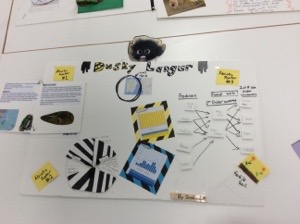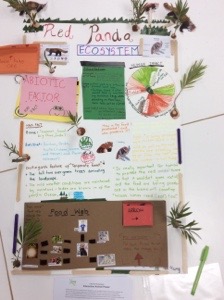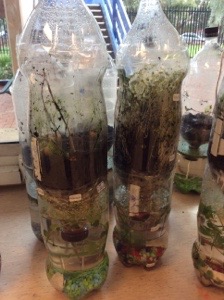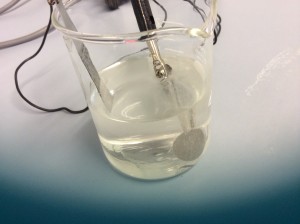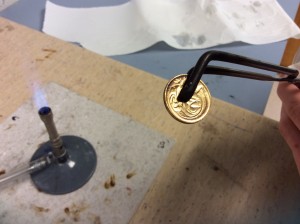Prof Bob. Hill filling in for Brian Schmidt.
Found out this morning that there is an iPad app for the Pasco software and an air attachment so no leads etc… Now have to keep persuading others to use this.
Key note address: Living with fire.
History of oxygen in atmosphere and then onto what we now know about the history and evolution of flowering plants.
All early fossilised plants served as charcoal. Fire a critical part in their early evolution.
Oxygen level below 13% can’t light a fire. Above 23% anything will burn anywhere – all vegetation. Above 30% spontaneous combustion.
Fire a very important part of the environment until about 60 million years ago less significant … Reduction of oxygen and climatic changes. Extremely high CO2 at the same time . No ice, tropical, forests at poles. Also very wet. No dry season.
These were the conditions in Australia until about 35 million years ago … Became more seasonal, temperature changed, less CO2 more fire. Current around Antarctica stopped movement of heat south from equator. Much larger temperature gradient. Summer winter rainfall boundary moved northward faster than Australia. Low nutrients also helped create a vegetation that was predisposed to burning when fire returns.
Poor nutrients and drying increase leaf litter. Eucalyptus are fire promoting. Xanthorrea is also another excellent example.
Epicormic shoots. Eucalypts do best when high fire frequency.
Fire plays a large impact on the type of vegetation cover. Big land surface of the Earth.
700000 definitely trees on the nullabor as tree kangaroos. Palm valley etc.
IncreAse in eucalypt about 200000 years ago so could it have been homo erectus using fire?
Diets of emus and genyornis before genyornis became extinct .. Emu diet became restricted C3 vs C4 plants materials. Converted drought adapted to fire adapted ?
Europeans interrupted the fire cycles created by original occupants. Including addition of annual weeds.
Dr Roslyn Prinsley national advisor science mathematics education industry.
Twitter feed @conasta
Big Science Competition? High percentage of students find Science interesting and think it can change the world (voluntary). But they don’t particularly want to work in Science.
What work do Scientists and Mathematicians do? Jobs growing 1.5 times faster than other areas. Important skills active working, critical thinking, complex problem solving and creative problem solving STEM graduates better equipped ( employers survey). Also STEM positions in employment increasing. Growing interest in supporting Science in schools. Scientific literacy of country needs to be lifted. 1118 occupations in which STEM grads work in over 600 industries.
Not a lot of positive support for a mention of Christopher Pine as Education minister.
CSIRO Education outreach still functioning and challenges etc still running.
Prof Lynn Koviac .. Food and nutrition flagship.
Science it takes guts!
Australia is getting older and fatter. 1 in 3 obese children 26% of children overweight or obese. Links to lots of metabolic diseases.
Challenge .. Longer healthier life … For the health system.
Chronic disease will account for 80% of disease burden … Huge cost problems.
Huge increase in proportion of population obese since 1980
Thinking about mega trends and what they mean for health.
Semmelweis and hand washing as an example.
Addressing the challenges through delivery modes, efficiency, prevention and new technologies.
3D printing of food.
Genomics science challenge, proteinomics, etc … Molecular biology of selves and how it interacts with genes. Epigenomics. Adding methyl groups to change activation of gene. Data deluge
Diet exposure lots of it is bio active. Has opportunity to interact with our genes that produce 100000 proteins 300 to 500 thousand metabolises. Also extended genome through microorganism.
Role of gut nutrient and fluid uptake, immune tolerance, defence against infections, signalling to the brain.
Human Micro Iomega Project first map of microbes 100000 species on an healthy person.
Might be worth finding video the hungry microbiome
Methyl DNA to produce a test for colorectal cancer. Blood test for people refusing feacal screening test.
Prof Andrew White intriguing chemists and annoying computer scientists cqc2t.org
Quantum computers
Two weird things about Quantum mechanics wave particle duality, entanglement
Half silvers mirror experiment 2 Pairs of. Been done with particles as large as buckyballs.
Bells inequalities
Culinary Analogy for entanglement. Using cake sampling in ovens on conveyor sampled randomly.
Einstein hidden variable theory …. Faster than light information.
Qubit
Electronic potential energy surfaces
Quantum chemistry
agx.white@gmail.com
Elizabeth Saunders. The differentiated science class.
Things to consider ….
Diversity, academic goals in content and skills, use of resources, choice/allocation, presentation, open/closed, formal/informal, abstract/concrete, individual/group/whole class, time length, assessment, homework, timeframe.
Options Activity grids bloom’s and gardner’s. Example of a year 9 communications Technology – I’ve done similar things. The trick is how to assess. Maybe look at the blooms level tasks and keep notes records. Zoe and I did something very similar but we did need to structure our choices better.
I thing there was a bit more money in this school than I’m used to having available.
Could you do this electronically?
We often do this process with points allocations for students to use in choice .. Higher points are awarded for create and evaluate tasks and less points for remember and understand with the task set so that more time was needed to do the higher order thinking skills tasks. Scaffold the completed task more completely would help too.
That’s a thought using the grid for homework setting. Of course homework would have to be done.
General questioning skills are a god idea too.
Just mentioned the points system.
Showed a maths example which looks like part of the whole maths I ran with middle school kids. I’ve been differentiating more than I thought.
Learning contracts … Used those but we barely have the time to do the negotiation. Which the presenter just said too.
Universal Design of Learning
This is big picture planning
Multiple means of representation, multiple means of expression, multiple means of engagement.
Choice rich tasks sometimes are definitely not enough….
Need to get a grain mill.

